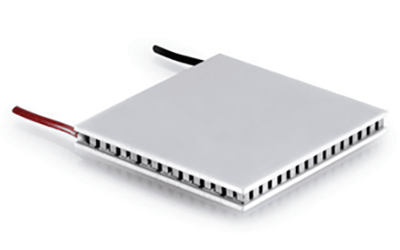What Is a Thermoelectric Cooler?

A Thermoelectric Cooler, also called a Peltier module, is a thermoelectric device that cools or heats a device by applying an electric current to it.
Thermoelectric Cooler is a module of semiconductor elements used in various cooling and heating devices. By quick conversion of the direction of the flowing current, the temperature control management of the object can be highly accurate and quickly heat up or exhaust heat.
This phenomenon is due to the Peltier effect that occurs when an electric current flows, and is incorporated not only in industrial applications, but also in familiar everyday products. The Peltier effect was discovered by French physicist Jean Charles Peltier in 1834. At the time of his discovery, two different metals were used, but today efficient semiconductors are used.
Applications for Thermoelectric Coolers
Thermoelectric Cooler elements are generally used in a wide range of fields as clean elements. For example, in the field of measurement and analysis, they are used to dehumidify spectrophotometers and gas analyzers, while in the field of optics, they are used to cool projectors and surveillance cameras.
In the consumer field, applications include cooling computer CPUs, air conditioners, air purifiers, hair dryers, cooler boxes, wine coolers, and medical equipment. Because of the expected reduction in production costs and high reliability, thermo-modules are also used in familiar consumer electronics products.
Principle of Thermoelectric Cooler
1. The Peltier Effect
Thermoelectric Cooler utilizes the phenomenon that heat is transferred from one metal to the other when a direct current is applied to the junction of two different metals. This is called the Peltier effect, and when an electric current is applied directly to the Thermoelectric Cooler, a temperature difference is generated on both sides of the element.
The low-temperature side absorbs heat and the high-temperature side generates heat, allowing heat to be transferred from the low-temperature side to the high-temperature side. Furthermore, by changing the polarity of the current, the direction of the heat pumping can be changed, and by changing the magnitude of the current, the amount of heat can also be changed.
This Peltier effect can be easily used for cooling, heating, and temperature control.
2. Thermoelectric Semiconductor Devices
The thermoelectric semiconductor elements most employed in recent years are welded blocks with distinct N and P characteristics or alloys of appropriately doped bismuth esterides. They are characterized by the directional nature of the material. The principle is then to transfer thermal energy by the difference between the extra electrons in the N material and the missing electrons in the P material.
Thermoelectric Cooler is a unit of P and N semiconductor elements connected in series in alternating PN patterns, sandwiched between ceramic substrates.
Other Information on Thermoelectric Cooler
1. Advantages of Thermoelectric Cooler
Cooling systems generally use refrigerant and require equipment such as compressors. Thermoelectric Coolers, on the other hand, do not require refrigerants or compressors, and have the advantages of being compact, lightweight, and vibration-free. They are also environmentally friendly cooling and heating devices. Another advantage is the ability to control temperatures with high precision. However, there is room for improvement in terms of efficiency.
Heat sinks, which are often used to cool electronic devices, only dissipate heat. Thermoelectric Coolers, on the other hand, can cool down to below ambient temperature, thus enabling efficient cooling.
2. Expansion of Thermoelectric Cooler Applications
Semiconductor lasers used in optical communication networks must maintain a constant laser wavelength to ensure stable communication information transmission. The key to stabilizing the wavelength is temperature. Thermoelectric Coolers are being used more and more for this application.
In addition, products with ion generators are now available in home appliances. While water purification systems release components that cause mold and bacteria, Thermoelectric Coolers cool the moisture in the air and condense it to produce clean ions without harmful components, thus saving power.
In addition, the PCR method, which tests for the presence of pathogens, amplifies DNA reactions. Thermoelectric Coolers are used in this case because precise temperature cycles with precise temperature control are required.